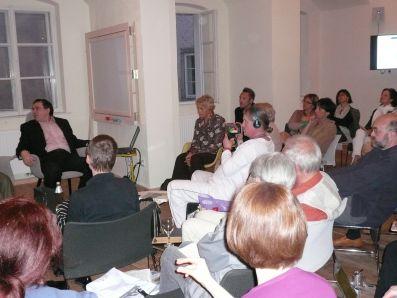Lectures / 22/04/2009 7:30 pm
Communication?
Colour policy. How colours serve as vehicles for meaning and attitudes.
The politicization of colours is only possible in regard to a few words and corresponding symbolic connotations. It would be difficult e.g. to imagine a vermilion faction fighting a scarlet one: red is red – full stop. Red may of course assume entirely different connotations depending on the context. To participants in a political rally red means something different than to pedestrians at a set of traffic lights or lovers in a flower shop. Red may signal eroticism and passion, or murder. In their respective contexts the significance of colour words is relatively fixed. Here we must be careful not to overlook the fact that all these contexts are usually rather narrowly defined and that we therefore constantly need to engage in multiple tasks of translation, which take place more or less without our being aware of them. Why does it not irritate us that in a Catholic church a red light alerts us to the presence of God, while the same red in a different part of town signifies the venality of sexual services?
continuative Links:
Bibliography:
- Bruns, Margarete: Das Rätsel Farbe. Materie und Mythos. Stuttgart: Reclam 1997.
- Brusatin, Manlio: Geschichte der Farben. Übersetzt von Sabine Schulz. Berlin: diaphanes 2003.
- Finlay, Victoria: Das Geheimnis der Farben. Eine Kulturgeschichte. Übersetzt von Charlotte Breuer und Norbert Möllemann. Berlin: List 2005.
- Gage, John: Die Sprache der Farben. Bedeutungswandel der Farbe in der bildenden Kunst. Übersetzt von Bram Opstelten. Ravensburg: Ravensburger Buchverlag Otto Maier 1999.
- Gage, John: Kulturgeschichte der Farbe. Von der Antike bis zur Gegenwart. Übersetzt von Magda Moses und Bram Opstelten. Leipzig: E.A. Seemann 2001.
- Garfield, Simon: Lila. Wie eine Farbe die Welt veränderte. Übersetzt von Hainer Kober. Berlin: Siedler 2001.
- Gekeler, Hans: Handbuch der Farbe. Systematik, Ästhetik, Praxis. Köln: DuMont 2000.
- Gericke, Lothar / Schöne, Klaus: Das Phänomen Farbe. Zur Geschichte und Theorie ihrer Anwendung. Berlin: Henschel-Verlag 1970.
- Heller, Eva: Wie Farben wirken. Farbpsychologie – Farbsymbolik – Kreative Farbgestaltung. Reinbek bei Hamburg: Rowohlt 1989.
- Itten, Johannes: Kunst der Farbe. Subjektives Erleben und objektives Erkennen als Wege zur Kunst. Stuttgart: Urania 1970.
- Jarman, Derek: Chroma. Ein Buch der Farben. Übersetzt von Almuth Carstens. Berlin: Merve 1995.
- Theroux, Alexander: Rot. Anleitungen eine Farbe zu lesen. Übersetzt von Michael Bischoff. Hamburg: Europäische Verlagsanstalt 1998. (Vgl. auch die Bände zu anderen Farben!)
- Ullrich, Wolfgang / Vogel, Juliane (Hrsg.): Weiß. Frankfurt am Main: Fischer Taschenbuch 2003.
- Wittgenstein, Ludwig: Bemerkungen über die Farben. Herausgegeben von G.E.M. Anscombe. Frankfurt am Main: Bibliothek Suhrkamp 1979.
- Zaunschirm, Thomas (Hrsg.): Die Farben Schwarz. Graz/Wien/New York: Landesmuseum Joanneum Graz/Springer 1999.








